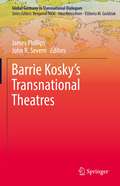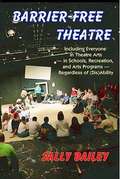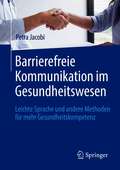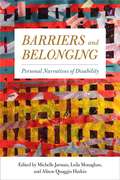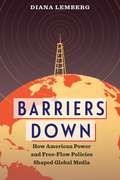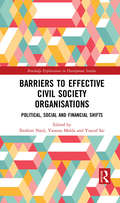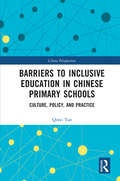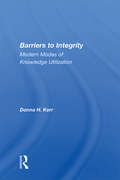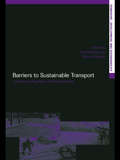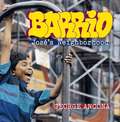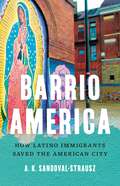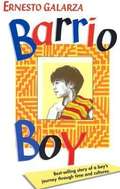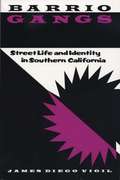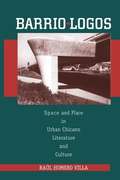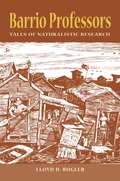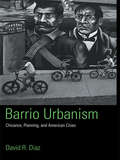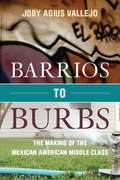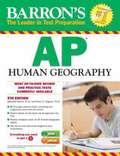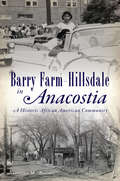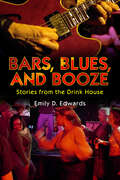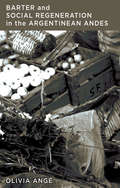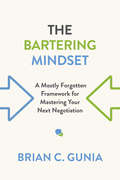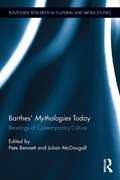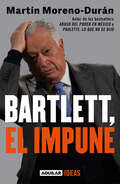- Table View
- List View
Barrie Kosky’s Transnational Theatres (Global Germany in Transnational Dialogues)
by James Phillips John R. SevernThis book, the first of its kind, surveys the career of the renowned Australian-German theatre and opera director Barrie Kosky. Its nine chapters provide multidisciplinary analyses of Barrie Kosky’s working practices and stage productions, from the beginning of his career in Melbourne to his current roles as Head of the Komische Oper Berlin and as a guest director in international demand. Specialists in theatre studies, opera studies, musical theatre studies, aesthetics, and arts administration offer in-depth accounts of Kosky’s unusually wide-ranging engagements with the performing arts – as a director of spoken theatre, operas, musicals, operettas, as an adaptor, a performer, a writer, and an arts manager. Further, this book includes contributions from theatre practitioners with first-hand experience of collaborating with Kosky in the 1990s, who draw on interviews with members of Gilgul, Australia’s first Jewish theatre company, to document this formative period in Kosky’s career. The book investigates the ways in which Kosky has created transnational theatres, through introducing European themes and theatre techniques to his Australian work or through bringing fresh voices to the national dialogue in Germany’s theatre landscape. An appendix contains a timeline and guide to Kosky’s productions to date.
Barrier-Free Theatre
by Sally BaileyWays to use drama as a tool to teach traditional classroom subjects, such as science, social studies, and language arts, are highlighted, as well as using it for instruction in social interaction and other vital life skills.
Barrierefreie Kommunikation im Gesundheitswesen: Leichte Sprache und andere Methoden für mehr Gesundheitskompetenz
by Petra JacobiDas Buch stellt die Möglichkeiten vor, allen Menschen den Zugang zu Kommunikation und Information im medizinischen Kontext ohne fremde Hilfe zugänglich zu machen. Die Autorin stellt die Grundlagen und Maßnahmen Barrierefreier Kommunikation wie Leichte Sprache, Unterstützte Kommunikation oder Digitale Barrierefreiheit vor und gibt Fachkräften im Gesundheitsbereich Tipps zur Anwendung. Sie lernen, wie Sie medizinische Sachverhalte leicht verständlich, zielgruppengerecht und patientenzentriert vermitteln, um Compliance und Adhärenz zu fördern.
Barriers and Belonging: Personal Narratives of Disability
by Alison Quaggin Harkin Leila Monaghan Michelle JarmanWhat is the direct impact that disability studies has on the lives of disabled people today? The editors and contributors to this essential anthology, Barriers and Belonging, provide thirty-seven personal narratives thatexplore what it means to be disabled and why the field of disability studies matters. The editors frame the volume by introducing foundational themes of disability studies. They provide a context of how institutions—including the family, schools, government, and disability peer organizations—shape and transform ideas about disability. They explore how disability informs personal identity, interpersonal and community relationships, and political commitments. In addition, there are heartfelt reflections on living with mobility disabilities, blindness, deafness, pain, autism, psychological disabilities, and other issues. Other essays articulate activist and pride orientations toward disability, demonstrating the importance of reframing traditional narratives of sorrow and medicalization. The critical, self-reflective essays in Barriers and Belonging provide unique insights into the range and complexity of disability experience.
Barriers Down: How American Power and Free-Flow Policies Shaped Global Media
by Diana LembergFreedom of information is a principle commonly associated with the United States’ First Amendment traditions or digital-era technology boosters. Barriers Down reveals its unexpected origins in political, economic, and cultural battles over analog media in the mid-twentieth century. Diana Lemberg traces how the United States shaped media around the world after 1945 under the banner of the “free flow of information,” showing how the push for global media access acted as a vehicle for American power.Barriers Down considers debates over civil liberties and censorship in Nazi Germany, the Soviet Union, and elsewhere alongside Americans’ efforts to circumvent foreign regulatory systems in the quest to expand markets and bring their ideas to new publics. Lemberg shows how in the decades following the Second World War American free-flow policies reshaped the world’s information landscape, though not always as intended. Through burgeoning information diplomacy and development aid, Washington diffused new media ranging from television and satellite broadcasting to global English. But these actions also spurred overseas actors to articulate alternative understandings of information freedom and of how information flows might be regulated. Bridging the historiographies of the United States in the world, human rights, decolonization and development, and media and technology, Barriers Down excavates the analog roots of digital-age debates over the politics and ethics of transnational information flows.
Barriers to Effective Civil Society Organisations: Political, Social and Financial Shifts (Routledge Explorations in Development Studies)
by Ibrahim Natil Vanessa Malila Youcef SaiThis book provides an insight into the historical changes and present-day circumstances that have influenced, and continue to influence, the development and future of civil society. Civil society organisations (CSOs) play a crucial role in international development, however their impact on policy and practice is limited by a range of shifts across their political, social and financial landscapes. Barriers to Effective Civil Society Organisations is divided into three parts addressing each of these shifts in turn, and places particular emphasis on civil society actors linked not only by political constraints, but also by ethnic and cultural diversities that are crucial markers of political and social identity. This book draws on case studies from across Latin America, Africa, MENA and Ireland to highlight how CSOs in these countries are shaped by, and react to, shifting challenges. Reflecting on solutions for the sector, the authors provide an understanding of the various ‘self-accommodation’ policies and techniques employed by CSOs in order to continue their services and increase their credibility across global contexts. Aimed at researchers, policy makers and CSO/NGO workers looking to better understand the current state and future of the sector from the perspective of emerging scholars working in these regions, and in the Global South in particular, this innovative book is a celebration of the important work of CSOs and a reaffirmation of their right to sit at the policy table.
Barriers to Inclusive Education in Chinese Primary Schools: Culture, Policy, and Practice (China Perspectives)
by Qinyi TanIn response to the growing international interest in inclusive education, this book examines its practices and issues in the Chinese context through case studies of two regular primary schools in mainland China where children with special needs are admitted. The main concerns of this book not only involve the inclusion of children with disabilities, but also those with special educational needs but without physical and sensory difficulties, such as children from socially and economically disadvantaged groups, children from diverse cultural and linguistic groups, and children alienated in classrooms. This book discusses these issues and challenges against the background of the existing educational system and policy, and identifies the barriers to their inclusion in current school education, such as lack of in-service training for teachers, limited involvement of local communities, big class size, and corporal punishment, etc. Academics and postgraduate students in the field of inclusive education, social education, and Chinese studies will find this book useful, as well as policy makers, school teachers, and administrators.
Barriers To Integrity: Modern Modes Of Knowledge Utilization
by Donna H. KerrIn the world of Aristotle, the education of individuals might have led to virtuous action. But today, integrity of action also requires the education of institutions. Those very structures designed to enhance the just use of knowledge too often stand instead as barriers to integrity. Bureaucracy shapes our actions in a manner reflective of a Platonic approach to knowledge and the political order—an approach that labels some as "true knowers" and grants them the ultimate power to decide what is to be done. Professionalism, the institution with which we legitimatize and use expertise, imbues our actions with the Aquinian belief that any disobedience of directives from reigning experts risks (unacceptably) the loss of order. In our research system, representing our main collective effort to generate new knowledge, we unwittingly put into practice Hume's conception of knowledge, which takes the outcomes of science to be an accumulation of facts, and John Stuart Mill's political theory, which overlooks the role of community in the lives of individuals. The stakes are high, argues Dr. Kerr. Given these conceptions of knowledge and the political values that are inherent in our primary modes of knowledge utilization—conceptions that we should not embrace—only with fundamental reforms of our institutions can our society hope to gain integrity. Dr. Kerr discusses how bureaucracy, professionalism, and the research system could be altered so that they might structure actions in more defensible and desirable ways.
Barriers to Sustainable Transport: Institutions, Regulation and Sustainability (Transport, Development and Sustainability Series)
by Piet Rietveld Roger R. StoughThe complexity of transportation systems and their negative social and environmental effects are today at the centre of attention. This book focuses on the impact of institutions and regulatory systems on transport systems and travel behaviour. While institutions appear to play an important role in the economic success of many countries, this book considers the extent to which they also support sustainable development.
Barrio: José's Neighborhood
by George AnconaWelcome to José's neighborhood. In his barrio, people speak an easy mix of Spanish and English and sometimes even Chinese. The masked revelry of Halloween leads into the festive remembrances of the Day of the Dead. And murals on the walls and buildings sing out the stories of the people who live here. As familiar as any neighborhood yet as strange as a foreign country, José's barrio isn't in Mexico or Argentina--it's in San Francisco. Award-winning author and photographer George Ancona follows José through a season in the barrio, and in the process gives readers a glimpse of a community as rich and varied as America itself.
Barrio America: How Latino Immigrants Saved the American City
by A. K. Sandoval-StrauszThe compelling history of how Latino immigrants revitalized the nation's cities after decades of disinvestment and white flight Thirty years ago, most people were ready to give up on American cities. We are commonly told that it was a "creative class" of young professionals who revived a moribund urban America in the 1990s and 2000s. But this stunning reversal owes much more to another, far less visible group: Latino and Latina newcomers.Award-winning historian A. K. Sandoval-Strausz reveals this history by focusing on two barrios: Chicago's Little Village and Dallas's Oak Cliff. These neighborhoods lost residents and jobs for decades before Latin American immigration turned them around beginning in the 1970s. As Sandoval-Strausz shows, Latinos made cities dynamic, stable, and safe by purchasing homes, opening businesses, and reviving street life. Barrio America uses vivid oral histories and detailed statistics to show how the great Latino migrations transformed America for the better.
Barrio Boy
by Ernesto GalarzaBarrio Boy is the remarkable story of one boy's journey from a Mexican village so small its main street didn't have a name, to the barrio of Sacramento, California, bustling and thriving in the early decades of the twentieth century. With vivid imagery and a rare gift for re-creating a child's sense of time and place, Ernesto Galarza gives an account of the early experiences of his extraordinary life—from revolution in Mexico to segregation in the United States—that will continue to delight readers for generations to come. Since it was first published in 1971, Galarza’s classic work has been assigned in high school and undergraduate classrooms across the country, profoundly affecting thousands of students who read this true story of acculturation into American life.
Barrio Gangs: Street Life and Identity in Southern California
by James Diego VigilWithin the Mexican American barrios of Los Angeles, gang activity, including crime and violent acts, has grown and flourished. In the past, community leaders and law enforcement officials have approached the problem, not as something that needs to be understood, but only as something to be gotten rid of. Rejecting that approach, James D. Vigil asserts that only by understanding the complex factors that give birth and persistence to gangs can gang violence be ended. Drawing on many years of experience in the barrios as a youth worker, high school teacher, and researcher, Vigil identifies the elements from which gangs spring: isolation from the dominant culture, poverty, family stress and crowded households, peer pressure, and the adolescent struggle for self-identity. Using interviews with actual gang members, he reveals how the gang often functions as parent, school, and law enforcement in the absence of other role models in the gang members' lives. And he accounts for the longevity of gangs, sometimes over decades, by showing how they offer barrio youth a sense of identity and belonging nowhere else available.
Barrio-Logos: Space and Place in Urban Chicano Literature and Culture
by Villa Raúl HomeroStruggles over space and resistance to geographic displacement gave birth to much of Chicano history and culture. In this pathfinding book, Raúl Villa explores how California Chicano/a activists, journalists, writers, artists, and musicians have used expressive culture to oppose the community-destroying forces of urban renewal programs and massive freeway development and to create and defend a sense of Chicano place-identity.
Barrio Professors: Tales of Naturalistic Research
by Lloyd H RoglerPrize-winning sociologist Lloyd H. Rogler, a founder of cultural psychiatry, gives us an intimately revealing, brilliantly narrated account of fieldwork from San Juan, Puerto Rico to inner-city New Haven. Using his decades of field experience and creative fiction he explores the daily reality of his "informants"—the Barrio Professors—and uncovers the clash between scientific models and local experience over schizophrenia, the political workings of community, and the power of serendipity. Rogler's multi-layered exploration of the relationship between researcher and community, as well as his candid assessment of field strategies, make the book useful also for methods courses. Barrio Professors is engrossing enough for the general public and an excellent text for courses in ethnic studies, sociology, qualitative methods, psychiatry, public health, anthropology, and social work.
Barrio Urbanism: Chicanos, Planning and American Cities
by David R. DiazThis, the first book on Latinos in America from an urban planning/policy perspective, covers the last century, and includes a substantial historical overview the subject. The authors trace the movement of Latinos (primarily Chicanos) into American cities from Mexico and then describe the problems facing them in those cities. They then show how the planning profession and developers consistently failed to meet their needs due to both poverty and racism. Attention is also paid to the most pressing concerns in Latino barrios during recent times, including environmental degradation and justice, land use policy, and others. The book closes with a consideration of the issues that will face Latinos as they become the nation's largest minority in the 21st century.
Barrios to Burbs: The Making of the Mexican American Middle Class
by Jody Agius VallejoToo frequently, the media and politicians cast Mexican immigrants as a threat to American society. Given America's increasing ethnic diversity and the large size of the Mexican-origin population, an investigation of how Mexican immigrants and their descendants achieve upward mobility and enter the middle class is long overdue. Barrios to Burbsoffers a new understanding of the Mexican-American experience. Vallejo explores the challenges that accompany rapid social mobility and examines a new indicator of incorporation, a familial obligation to "give back" in social and financial support. She investigates the salience of middle-class Mexican Americans' ethnic identification and details how relationships with poorer coethnics and affluent whites evolve as immigrants and their descendants move into traditionally white middle-class occupations. Disputing the argument that Mexican communities lack high quality resources and social capital that can help Mexican Americans incorporate into the middle class, Vallejo also examines civic participation in ethnic professional associations embedded in ethnic communities.
Barron's AP Human Geography (Fifth Edition)
by Meredith Marsh Peter S. AlagonaIn-depth preparation for the AP Human Geography exam features: Two full-length practice exams with answers and explanations A short diagnostic test to help students target areas where they need more study A new course review outline covers map reading and understanding scale, population geography, cultural geography, political geography, economic geography, agricultural and rural geography, and urban geography This manual can be purchased alone or with an optional CD-ROM that presents two additional full-length practice tests with automatic scoring and fully explained answers. BONUS! An exclusive online exam included with the purchase of the book or the book with CD-ROM.
Barron's AP Human Geography With Bonus Online Tests, 7th edition: With Bonus Online Tests
by Meredith Marsh Peter S. AlagonaIn-depth preparation for the AP Human Geography exam features: Two full-length practice exams with answers and explanationsA diagnostic test to help students target areas where they need more studyA subject review covering map reading and understanding scale, population geography, cultural geography, political geography, economic geography, agricultural and rural geography, and urban geographyBONUS ONLINE PRACTICE TESTS: Students who purchase this book will also get FREE access to three additional full-length online AP Human Geography tests with all questions answered and explained. The online exams can be easily accessed by computer, tablet, and smartphone.
Barry Farm-Hillsdale in Anacostia: A Historic African American Community (American Heritage)
by Alcione M. AmosBarry Farm-Hillsdale was created under the auspices of the Freedmen's Bureau in 1867 in what was then the outskirts of the nation's capital. Residents built churches and schools, and the community became successful. In the 1940s, youth from the community courageously desegregated the Anacostia Pool, and Barry Farm Dwellings was built to house war workers. In the 1950s, community parents joined the fight to desegregate schools in Washington, D.C., as local leaders fought off plans to redevelop the area. Both the women and the youth of Barry Farm Dwellings, then public housing, were at the forefront of the fight to improve their lives and those of their neighbors in the 1960s, but community identity was being subsumed into the larger Anacostia neighborhood. Curator and historian Alcione M. Amos tells these little-remembered stories.
Bars, Blues, and Booze: Stories from the Drink House (American Made Music Series)
by Emily D. EdwardsBars, Blues, and Booze collects lively bar tales from the intersection of black and white musical cultures in the South. Many of these stories do not seem dignified, decent, or filled with uplifting euphoria, but they are real narratives of people who worked hard with their hands during the week to celebrate the weekend with music and mind-altering substances. These are stories of musicians who may not be famous celebrities but are men and women deeply occupied with their craft--professional musicians stuck with a day job. The collection also includes stories from fans and bar owners, people vital to shaping a local music scene. The stories explore the "crossroads," that intoxicated intersection of spirituality, race, and music that forms a rich, southern vernacular. In personal narratives, musicians and partygoers relate tales of narrow escape (almost getting busted by the law while transporting moonshine), of desperate poverty (rat-infested kitchens and repossessed cars), of magic (hiring a root doctor to make a charm), and loss (death or incarceration). Here are stories of defiant miscegenation, of forgetting race and going out to eat together after a jam, and then not being served. Assorted boasts of improbable hijinks give the "blue collar" musician a wild, gritty glamour and emphasize the riotous freedom of their fans, who sometimes risk the strong arm of southern liquor laws in order to chase the good times.
Barter and Social Regeneration in the Argentinean Andes
by Olivia AngéDespite the pervasiveness of barter across societies, this mode of transaction has largely escaped the anthropologist's gaze. Drawing on data from fairs in the Argentinean Andes, this book explores fairs' embeddedness within religious celebration, arguing that barter is addressed as a sacrifice to catholic figures and local ancestors, and thus challenging a widespread view of barter as a non-monetary form of commodity exchange. Issues of value, identity, and exchange are considered, furthering our understanding of how social groups create themselves through material circulation.
The Bartering Mindset: A Mostly-Forgotten Framework for Mastering Your Next Negotiation (G - Reference, Information and Interdisciplinary Subjects)
by Brian GuniaEver wonder why negotiating is so hard—why many of us don’t get the critical raise, can’t convince the teenager to get home on time, and never leave the car dealer feeling very good? According to The Bartering Mindset, the answer lies all around us—in our many daily monetary transactions. In particular, the book suggests that our daily exposure to money leads us to use think about negotiations as monetary transactions (adopt a "monetary mindset"), which inevitably prompts us to make counterproductive assumptions about negotiation and thus negotiate badly. So is everyone in a monetary economy fated to fail? Luckily not, since money is far from the only metaphor we can use for negotiations. The Bartering Mindset argues that by thinking about negotiations as bartering trades instead (adopting the "bartering mindset"), we can all learn to negotiate better and more productively. And it trains you to do just that through a straightforward, five-step process. Ultimately, The Bartering Mindset reminds you of a "mostly forgotten" mindset that will make even the most challenging, money-focused negotiations negotiable!
Barthes' Mythologies Today: Readings of Contemporary Culture (Routledge Research in Cultural and Media Studies)
by Julian McDougall Pete BennettThis is Barthes’ seminal text reimagined in a contemporary context by contemporary academics. Through a revisiting of Mythologies, a key text in cultural and media studies, this volume explores the value these disciplines can add to an understanding of contemporary society and culture. Leading academics in media, English, education, and cultural studies here are tasked with identifying the "new mythologies" some fifty or so years on from Barthes’ original interventions. The contributions in this volume, then, are readings of contemporary culture, each engaging with a cultural event, practice, or text as mythological. These readings are then contextualized by an introduction which reflects on the ‘how’ of these engaging responses and an "essay at the back of the book" which replaces Myth Today with a reflection on the contemporary provenance of both Barthes and his most famous book. Thus the book is at least two things at once whichever way you look: a ‘new’ Mythologies and a book about Barthes’ legacy, an exploration of the place of theory in critical writing, and a book about contemporary culture.
Bartlett: el impune
by Martín MorenoBartlett, el impune, está armado con entrevistas, documentos reveladores, datos duros amargos, testimonios de personalidades cercanas a Bartlett y confidencias periodísticas. El libro muestra el autoritarismo, complicidades y corruptelas de este político ultranacionalista que, con AMLO, quien lo escucha sumiso y lo obedece, son actores principales de la ruina política y económica que soporta México. Con Bartlett, el impune, Martín Moreno-Durán confirma que es el periodista más punzante del sistema político mexicano: ha señalado, con nombres y hechos, los abusos, el desfalco y la insolencia de los gobiernos corruptos del PRI, del PAN y de Morena. Por primera vez se ofrece en un libro el perfil más amplio de uno de los políticos más siniestros y poderosos del México contemporáneo: Manuel Bartlett Díaz. Priista de línea dura, implicado en el asesinato del agente de la DEA, Enrique Kiki Camarena; verdugo en la penumbra del crimen del célebre periodista Manuel Buendía; hombre clave que impidió el triunfo legítimo de Cuauhtémoc Cárdenas en las oscuras elecciones de 1988 y actualmente el hombre más poderoso del gobierno de AMLO, quizá, aún más potente que el presidente.
